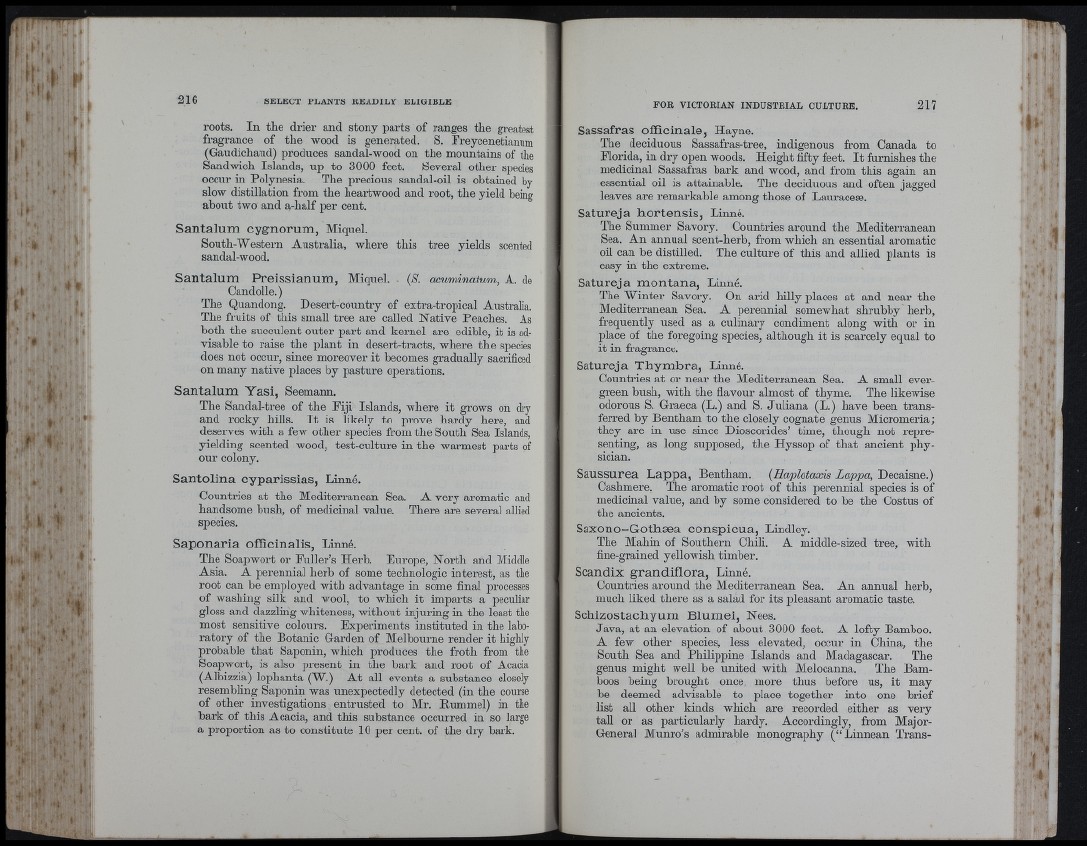
* '
‘ » I
roots. In the drier and stony parts of ranges the greatest
fragrance of the wood is generated. S. Freycenetianum
(Gaudichand) produces sandal-wood on the mountains of the
Sandwich Islands, up to 3000 feet. Several other species
occur in Polynesia. The precious sandal-oil is obtained by
slow distillation from the heartwood and root, the yield being
about two and a-lialf per cent.
Santalum cygnomm, Miquel.
South-Western Australia, where this tree yields scented
sandal-wood.
Santalum Preissianum, Miquel. (S. acuminatum, A. de
Candolle. )
The Qnandong. Desert-country of extra-tropical Australia.
The fruits of this small free are called Native Peaches. As
both the succulent outer part and kernel are edible, it is advisable
to raise the plant in desert-tracts, where the species
does not occur, since moreover it becomes gradually sacrificed
on many native places by pasture operations.
Santalum Yasi, Seemann.
The Sandal-tree of the Fiji Islands, where it grows on dry
and rocky hills. I t is likely to prove hardy here, and
deserves with a few other species from the South Sea Islands,
yielding scented wood, test-culture in the warmest parts of
our colony.
Santolina cyparissias, Linné,
Countries at the Mediterranean Sea. A very aromatic and
handsome bush, of medicinal value. There are several allied
species.
Saponaria officinalis, Linné.
The Soap wort or Fuller’s Herb, Europe, North and Middle
Asia. A perennial herb of some technologic interest, as the
root can be employed with advantage in some final processes
of washing silk and wool, to which it imparts a peculiar
gloss and dazzling whiteness, without injuring in the least the
most sensitive colours. Experiments instituted in the laboratory
of the Botanic Garden of Melbourne render it highly
probable that Saponin, which produces the froth from the
Soapwort, is also present in the bark and root of Acacia
(Albizzia) lopbanta (W.) A t all events a substance closely
resembling Saponin was unexpectedly detected (in the course
of other investigations entrusted to Mr. Hummel) in the
bark of tbis Acacia, and this substance occurred in so large
a proportion as to constitute 10 per cent, of the dry bark.
Sassafras officinale, Hayne.
The deciduous Sassafras-tree, indigenous from Canada to
Florida, in dry open woods. Height fifty feet. I t furnishes the
medicinal Sassafras bark and wood, and from tbis again an
essential oil is attainable. Tbe deciduous and often jagged
leaves are remarkable among those of Lauraceæ.
Satureja hortensis, Linné.
The Summer Savory. Countries around the Mediterranean
Sea. An annual scent-herb, from wbich an essential aromatic
oil can be distilled. The culture of this and allied plants is
easy in the extreme.
Satureja montana, Linné.
The Winter Savory. On arid hilly places at and near the
Mediterranean Sea. A peremiial somewhat shrubby herb,
frequently used as a culinaxy condiment along with or in
place of the foregoing species, although it is scarcely equal to
it in fragrance.
Satureja Thymbra, Linné.
Countries at or near the Mediterranean Sea. A small evergreen
bush, with the flavour almost of thyme. The likewise
odorous S. Graeca (L.) and S. Juliana (L.) have been transferred
by Bentham to tbe closely cognate genus Micromeria;
they are in use since Dioscorides’ time, though not representing,
as long supposed, the Hyssop of that ancient physician.
Saussurea Lappa, Bentham, (Haplotaxis Lappa, Decaisne.)
Cashmere. The aromatic root of this perennial species is of
medicinal value, and by some considered to be the Costus of
the ancients.
Saxono-Gotbæa conspicua, Lindley.
The Mahin of Southern Chili. A middle-sized tree, with
fine-grained yellowish timber.
Scandix grandiflora, Linné.
Countries around tbe Mediterranean Sea. An annual herb,
much liked there as a salad for its pleasant aromatic taste.
Schizostachyum Blumei, Nees.
Java, at an elevation of about 3000 feet. A lofty Bamboo.
A few other species, less elevated, occur in China, the
South Sea and Philippine Islands and Madagascar. The
genus might well be united with Melocanna, The Bamboos
being brought once, more thus before us, it may
be deemed advisable to place together into one brief
list all other kinds which are recorded either as very
tall or as particularly hardy. Accordingly, from Major-
General Munro’s admirable monograpby (“ Linnean Transt
,
I
M ■!
r t